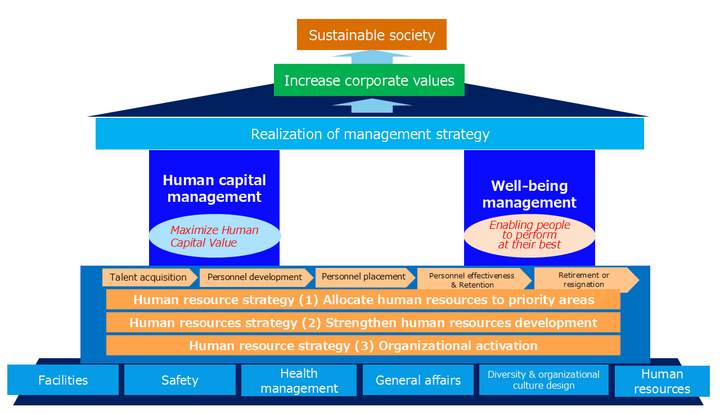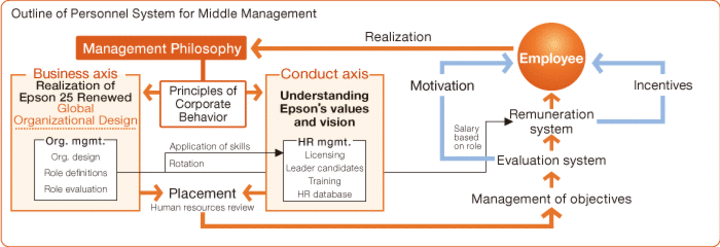Human Resource Strategy
- Basic approach to human resource strategy
- Image of human resources we seek
- Human Resources Management
Basic Approach to Human Resource Strategy
Epson is a company that was born and raised in Shinshu. While still having the core functions and foundation of business operations in Shinshu, we are expanding our business globally by establishing R&D, production, and sales bases in overseas countries and regions that account for approximately 80% of sales revenue and more than 70% of the number of employees. Therefore, at Epson, the essence of our human resources strategy is to actively acquire external human resources and achieve diversity, overcome fierce global competition, and build a human resource base to achieve management goals and business growth, while turning local employment and relatively long-term employment into strengths. Specifically, the following are the key points.
- We will accurately grasp various customer needs and promote business reform and innovation to respond quickly and flexibly. To this end, we will actively acquire specialists from outside the Company in growth and new fields in addition to highly specialized fields, as well as management personnel who can work from a managerial perspective. We will also provide our own staff with specialized training and conversion training to focus on areas to be strengthened and build optimal formations from a global perspective.
- As a company where people continue to grow and develop their careers autonomously over a long-term time horizon, Epson will provide various training programs, reskilling, rotations, internal recruitment systems, and other opportunities to take on new challenges, thereby enhancing each employee's ability to respond to changes in the internal and external environment. In addition, to build an optimal formation from a global perspective, we will develop and assign human resources who can work globally, including overseas personnel.
- Foster an organizational culture in which human resources with diverse abilities, skills, and personalities can think and act on their own, enhance the creativity of the entire organization, and realize innovation, while continuing to take on positive challenges without fear of failure. In addition, we will work to create a working environment that takes advantage of our position as a regional company, and through these efforts, we will increase employee engagement and maximize the teamwork of the organization.
Epson's Human Resources Strategy Overview of Initiatives
Epson will enhance employee autonomy and responsiveness to changes in the environment, improve employee motivation and engagement, promote the activities of human resources that create value, and foster an organizational culture that continues to take on challenges in a positive manner without fear of failure. By doing so, we aim to maximize the value of our human resources and contribute to the enhancement of our corporate value over the medium to long term, and are developing a human resources strategy based on human capital management and well-being management.

Image of Human Resources We Seek
To execute business and realize its management strategy, Epson needs human resources who can respond quickly to change with a broad perspective and a high level of expertise, and create customer value independently and autonomously from the customer's perspective, based on the penetration of Purpose, Epson Way, and the shared direction of business set forth in the long-term vision.
We are developing a global HR portfolio to compensate for Japan’s declining birthrate and shrinking labor pool. In FY2024, 70% of our operations divisions and corporate divisions finished visualizing their current (as-is) human resource portfolio by defining human resource requirements in terms of skills, knowledge, and behavioral characteristics. In FY2025, the remaining operations divisions and corporate divisions will complete their as-is portfolios as soon as possible. The next step is to visualize the desired (to-be) human resource portfolio in parallel with the formulation of the management strategies in the upcoming long-term corporate vision so that we can identify gaps between the current and future portfolios in terms of both quantity and quality. We will then fill those gaps by recruiting, reskilling, and shifting people as needed to execute the management strategies, build an optimal personnel structure, and formulate a human resource strategy that will contribute to the realization of our medium- to long-term business strategy.
Human Resource Portfolio
Using the as-is and to-be talent portfolios, we identify gaps in the quality and quantity of the talent required to formulate and execute business strategies and establish new business models, primarily from the perspective of skills and behavioral characteristics.
In response, we refer to the skill level map of our members and determine whether the needs can be met through skill development, reskilling, or resource shifting, or whether we need to acquire external talent.
We also envision using the talent portfolio to encourage communication between managers and employees, leading to employees' own voluntary learning and growth.

Human Resources Management
Allocating Human Resources to Priority Areas
Epson formulates staffing plans based on forecasts of the future changes in its workforce structure and the workforce needs to realize its business strategies.
We plan to steadily hire more than 350 new graduates and mid-career workers combined each year over the medium term.
We strategically allocate personnel to growth areas such as printing (office, commercial and industrial) and new areas such as environmental business and environmental technology. In addition, we are actively upskilling and reskilling employees to prepare them for different roles in priority areas. At the same time, we are clearly defining our talent requirements and recruiting external professionals, including management personnel and specialists in digital transformation (DX), to strengthen our organizational capabilities. In FY2024, 380 out of a total of 549 employees (including new graduates, mid-career hires, and employees transitioning to new jobs) were assigned to priority areas.
In addition to recruiting the numbers we need, we are looking to increase diversity and are actively recruiting women, seniors, persons with disabilities, and foreign nationals. We have set a hiring goal of 25% women for new graduates.
Employment of foreign nationals will be examined from multiple angles. Some foreign nationals will be hired in Japan. Others may be brought over from our overseas subsidiaries. Things will be looked at from a site strategy perspective, as well.
We have already transferred some printer design functions to a Group company in Indonesia.
Number of Hires
| FY2020 | FY2021 | FY2022 | FY2023 | FY2024 | Targets | |
|---|---|---|---|---|---|---|
| New graduates | 344 | 200 | 250 | 344 | 373 | Continue to hire over 350 people each fiscal year1 |
| Mid-career | 30 | 48 | 241 | 204 | 70 |
1Total number of new graduates who joined the Company on April 1 of each fiscal year and the number of mid-career hires in each fiscal year
Placement to Priority Areas
| FY2021-2023 Total | FY2024 Plan | FY2024 Result | |
|---|---|---|---|
| Total placements | 1,881 | 503 | 549 |
| Allocation to priority areas | 1,313 | 374 | 380 |
Number of employees hired and placed through internal recruitment
Human Resource Review and Succession Planning
The concept of "role" is the basis for the placement of human resources and their assignment to positions. The basic approach is to design a global organization to execute business strategies, define the roles of each position within the organization, and then allocate and appoint the most appropriate people to that role.
To achieve this, the company conducts an annual human resources review at each echelon of the organization to get a bird's eye view of the staffing situation, list potential successors for each position, and review their skill development needs.
As in Japan, we also work with local top management and human resource departments to define roles and requirements for overseas human resources, and formulate succession and training plans for key positions and key human resources. Based on these activities, we are working to build an optimal formation from a global perspective.




